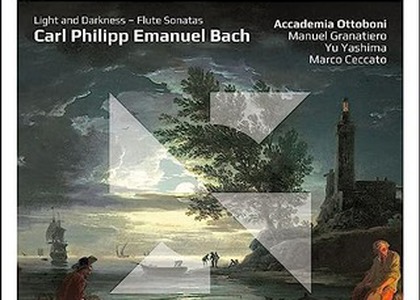Disk of 2023

The flautist Manuel Granatiero - album “Light and Darkness” - CD Review, February20th, 2023
The flautist Manuel Granatiero released his first album as a soloist, after previously becoming known in the music scene as a member of the Gli Incogniti Ensemble led by Amandine Beyer and as one of the founding members of the Ottoboni Academy, an ensemble specializing in early and classical music, established in 2004."Light and Darkness"is the title of this material inspired by a quote from Goethe that appears as a motto in the presentation of the album. But how does Manuel Granatiero descrie this new experience?" Singing and listening to the music of Emanuel Bach means for me to open a window to a new world, a world wher eopposites coexist, at the same time close and distant. The alternation, if not the coexistence, of light and dark is the aspect that most fascinated me in the pages recorded here. Behind a clear and rational formal structure, there continually appears the sign of an approaching change, with its intimate, inner, and irrational elements designed to shatter the old world. Looking into the hidden places of the human soul, he has a vision of what music will be beyond the Enlightenment".
In other words, Carl Philipp Emmanuel Bach, the second son of the Leipzig Cantor is presented as a trailblazer, not only in the sphere of the clavier repertoire, but also for the flute, the favorite instrument of King Frederick the Great, in whose service Carl Philipp Emmanuel Bach was for 30 years. A first Sonata in A minor for flute and basso continuo was composed for the king in Berlin in 1740, with features typical of the new gallant style, of a largeexpressiveness and technical scope, "a compliment to the king's talent as a flautist", writes the American historian Steven Zorn, who edited these sonatas - an overdue compliment to the performers - flautist Manuel Granatiero, accompanied by cellist Marco Ceccatoand harpsichordistYu Yashima- members of the Ottoboni Academy.
A comparison can be made between this mature sonata, typical of the"Sentimental Style", and another, long attributed to Johann Sebastian Bach, still tributary to the baroque discourse. It would be dated around the 1730s, from the Leipzig period - it is one of the first sonatas for flute and harpsichord obliggato, composed by Carl Philipp Emmanuel Bach, possibly under the supervision of his father. What is interesting is the profile of this album in which sonatas composed by the German author throughout his life are selected, offering an X-Ray of the evolution of his style.
I also stop at another score - the Trio-Sonata in D major which, like the Sonata for solo flute, dates from 1747. But years later, once I arrived in Hamburg as Telemann's successor in the post ofkapellmeister, Carl Philipp Emmanuel Bach adapted this sonata for the flute - harpsichord obbligato version, modernizing the sound material of the score according to the latest trends. The course is thus complete in terms of the German author's career.
As a general note, the flautist Manuel Granatiero, together with his colleagues from the OttoboniAccademy, give this music a special expressive quality, expressing the traits of the Sentimental Style ("Empfindsamer Stil"), beyond the impeccable technical mark and stylistic appropriation of a proverbial accuracy. Maybe I would't have assigned the light-dark opposition as a motto for this grouping of sonatas, which only express different degrees of light, variations and intensities, on a meditative or euphoric level. However, it remains an essential page in the history of European music that we appropriate with particular pleasure.














